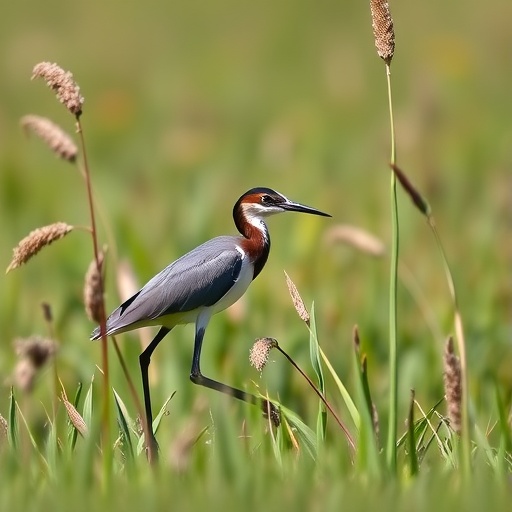In a world where environmental issues and agricultural practices often collide, recent research has shed new light on an alarming connection between irrigated agriculture and selenium levels in endangered marsh birds. As humanity strives to feed an ever-growing population, the implications of agricultural practices on the ecosystem have become a focal point of scientific inquiry. The study conducted by Yost, Sliwa, and Shafique-Sabir, published in Environmental Monitoring and Assessment, explores how the influx of irrigation in agricultural landscapes affects not only the immediate agricultural yield but also the habitats of vulnerable wildlife. This research underscores a vital intersection between agriculture, ecology, and conservation efforts.
Selenium, a trace element essential for various wildlife and human health, becomes a double-edged sword when its levels are affected by agricultural practices. While low levels of selenium contribute positively to health, excessive amounts can have detrimental effects. The current study examines the intricate balance of selenium within the context of irrigated agriculture, diving deep into how this relationship poses threats to the survival of critically endangered marsh birds and the broader ecosystem. The implications of their findings resonate profoundly, suggesting that irrigation practices, aimed at boosting agricultural productivity, could inadvertently endanger species that play crucial roles in their habitats.
The implications of the research are far-reaching. Marsh birds are integral components of their ecosystems, contributing to pest control, seed dispersal, and other vital ecological functions. The study highlights the sensitivity of these birds to changes in their environment, particularly those wrought by human activities like farming and commercial irrigation. As marsh habitats become increasingly altered by agricultural practices, the stability of these avian populations faces imminent threat. The researchers’ findings elevate the importance of establishing a dialogue between agricultural initiatives and conservation measures, as the future of these species hangs in the balance.
By analyzing selenium levels across different irrigation practices, the study demonstrates a clear link between agricultural intensification and increased selenium concentration within nearby marsh ecosystems. The impact of irrigation on selenium bioaccumulation within the food chain ultimately places additional stress on marsh birds. The researchers utilized advanced sampling and analytical techniques to draw comparisons between irrigation methodologies, revealing how some forms of irrigation disproportionately increase selenium levels in aquatic environments. Their work emphasizes that these findings are not merely isolated observations but part of a larger narrative about sustainable agricultural practices and their ecological ramifications.
In understanding the mechanism of selenium bioaccumulation, researchers found that the shallow water prevalent in irrigated areas promotes the growth of aquatic plants that bioaccumulate selenium. As these selenium-enriched plants become primary sources of food for marsh birds, the biomagnification of selenium occurs. This phenomenon poses a severe risk of toxicity, leading to reproductive and developmental issues in affected bird populations. Thus, the consequences of high selenium levels stretch beyond immediate food supply concerns, as they further emphasize the intricate connections within ecosystems.
Addressing the ensuing challenges involves a combination of strategic agricultural reforms and robust conservation initiatives. While agricultural productivity is paramount, balancing output with environmental health is crucial. Policymakers, farmers, and conservationists must collaborate to create irrigation systems that minimize harmful ecological impacts while maximizing crop yield. The study advocates for the promotion of more sustainable irrigation practices, such as precision irrigation or the reduction of supplemental fertilizers, to mitigate the risk of selenium leaching into marsh habitats.
In light of these findings, the role of science becomes increasingly significant in shaping effective environmental policies. Researchers provide essential data that not only informs stakeholders but equips them with knowledge to enact change. Education and awareness campaigns aimed at farmers regarding the environmental impact of irrigation on selenium levels can foster a culture of responsibility towards both agricultural practices and wildlife conservation.
The study also prompts further research into the bioaccumulation of selenium across various ecosystems and its impact on other species. It invites inquiry into the synergistic effects of selenium with other environmental stressors, such as climate change and habitat fragmentation, on marsh bird populations. Understanding these complex interactions will be vital for informing future conservation strategies and ensuring the survival of endangered species.
As we forge ahead into an increasingly complex agricultural landscape, maintaining biodiversity must remain a priority. The interconnectedness of farming practices and wildlife preservation offers an opportunity for reduced conflict between development and conservation. If managed effectively, modern agriculture can coexist with vibrant ecosystems, nurturing both human needs and the survival of endangered species.
In conclusion, the findings from the study led by Yost, Sliwa, and Shafique-Sabir draw essential attention to the intricate relationship between irrigation practices and selenium levels in endangered marsh birds. They raise significant questions about how best to integrate agricultural advancement with ecological stewardship. The pressing need to reinforce these bonds is underscored for the sake of not only marsh birds but the entirety of our planet’s fragile ecosystems. As this research becomes part of a larger conversation, it paves the way for action-oriented approaches that align agricultural productivity with wildlife conservation, ultimately benefiting both humankind and the environment.
As concerted efforts unite stakeholders from various sectors, solutions can be explored and implemented to ensure that agricultural practices not only enrich human life but also protect the delicate tapestry of nature on which we all depend.
Subject of Research: Investigating the influence of irrigated agriculture on selenium levels in endangered marsh birds.
Article Title: Irrigated agriculture influences selenium levels in an endangered marsh bird.
Article References:
Yost, C.M., Sliwa, K.M., Shafique-Sabir, R. et al. Irrigated agriculture influences selenium levels in an endangered marsh bird. Environ Monit Assess 197, 1142 (2025). https://doi.org/10.1007/s10661-025-14533-1
Image Credits: AI Generated
DOI:
Keywords: Selenium, Endangered species, Marsh birds, Irrigated agriculture, Environmental conservation.




